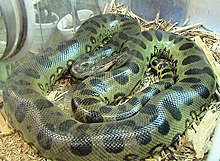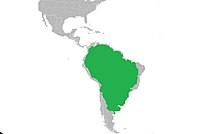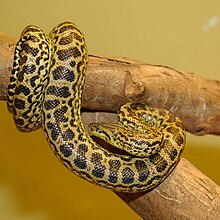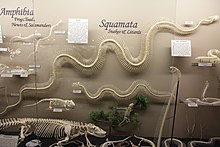Eunectes Contents Distribution and habitat Feeding Relationship with humans Species Mating System See also References Further reading External links Navigation menu"Presence of the genus Eunectes (Serpentes, Boidae) in the Neogene of Southwestern Amazonia, Brazil"10.1670/08-295.1"Eunectes"Eunectes beniensisReptarium.cz Reptile Database"Frequently Asked Questions""Life history and conservation of the green anaconda (Eunectes murinus)""Reproductive ecology of boine snakes with emphasis on Brazilian species and a comparison to pythons"10.2994/1808-9798(2007)2[107:reobsw]2.0.co;210.1006/anbe.2001.1755"Snake mating systems, behavior, and evolution: The revisionary implications of recent findings"10.1037/0735-7036.119.4.447"Facultative parthenogenesis validated by DNA analyses in the green anaconda (Eunectes murinus)"10.1371/journal.pone.0189654572850829236745Natural History of the green anaconda (Eunectes murinus) in the Venezuelan llanosanacondas.orgEunectes356431EUNEG3809924652733221120957751875
BoinaeFauna of BrazilFauna of the AmazonSnakes of South AmericaReptiles of Trinidad and TobagoSnake generaTaxa named by Johann Georg Wagler
genusboasSouth AmericaspeciesSouth AmericaEcuadorBrazilColombiaVenezuelaArgentinafishcaimancapybarasgoatsAmazon junglefolkloreencantadosgiant anacondasDr. Jesus RivasSexual size dimorphismfecunditymate choicesperm competitionpolyandrouscloacapelvic spurssexual cannibalismfacultative parthenogenesis
Eunectes
Jump to navigation
Jump to search
Eunectes Temporal range: Miocene–recent[1] | |
|---|---|
 | |
| Green anaconda, E. murinus | |
Scientific classification | |
| Kingdom: | Animalia |
| Phylum: | Chordata |
| Class: | Reptilia |
| Order: | Squamata |
| Suborder: | Serpentes |
| Family: | Boidae |
| Subfamily: | Boinae |
| Genus: | Eunectes Wagler, 1830[2] |
Type species | |
Eunectes murinus (Linnaeus, 1758)[2] | |
 | |
| Range of Eunectes | |
Synonyms | |
| |
- Common names: anacondas.
Eunectes is a genus of boas found in tropical South America. They are a semiaquatic group of snakes and include one of the largest snakes in the world, E. murinus, the green anaconda. The name Eunectes is derived from the Greek word Eυνήκτης, which means "good swimmer". Four species are currently recognized.[3][4]
Contents
1 Distribution and habitat
2 Feeding
3 Relationship with humans
4 Species
5 Mating System
5.1 Sexual dimorphism
5.2 Breeding balls
5.3 Sexual cannibalism
5.4 Asexual reproduction
6 See also
7 References
8 Further reading
9 External links
Distribution and habitat
Found in tropical South America from Ecuador, Brazil, Colombia and Venezuela south to Argentina.[2]
Feeding
All four species are aquatic snakes that prey on other aquatic animals, including fish, river fowl, caiman, and capybaras. Some accounts exist of anacondas preying on domestic animals such as goats[5] that venture too close to the water.
Relationship with humans
While encounters between people and anacondas may be dangerous, they do not regularly hunt humans. Nevertheless, threat from anacondas is a familiar trope in comics, movies and adventure stories set in the Amazon jungle. Anacondas have also figured prominently in South American folklore, where they are sometimes depicted as shapeshifting mythical creatures called encantados. Local communities and some European explorers have given accounts of giant anacondas, legendary snakes of much greater proportion than any confirmed specimen.
Although charismatic, there is little known on the biology of wild anacondas. Most of our knowledge comes from the work of Dr. Jesus Rivas and his team working in the Venezuelan llanos.[6]
Species

Yellow anaconda

The green anaconda, Eunectes murinus, has been used for many commercially successful films, as a deadly creature.

Bolivian anaconda
| Species | Taxon author | Subspecies other than nominate[3] | Common name | Geographic range |
|---|---|---|---|---|
E. beniensis | Dirksen, 2002[7] | 0 | Bolivian anaconda | South America in the Departments of Beni and Pando in Bolivia. |
E. deschauenseei | Dunn and Conant, 1936[3] | 0 | Dark-spotted anaconda | South America in northeastern Brazil and coastal French Guiana.[2] |
E. murinus | (Linnaeus, 1758)[3] | 1 | Green anaconda | South America in countries east of the Andes, including Colombia, Venezuela, the Guianas, Ecuador, Peru, Bolivia, Brazil and on the island of Trinidad.[2] |
E. notaeus | Cope, 1862[3] | 0 | Yellow anaconda | South America in eastern Bolivia, southern Brazil, Paraguay and northeastern Argentina.[2] |
E. stirtoni | Hoffstetter and Rage, 1977[8] | 0 | This species is extinct; their fossils have been found in the La Venta fauna (Miocene) in Colombia. |
Mating System
The mating seasons in Eunectes varies both between species and within species depending on locality, although the trend appears to be the dry season.[9][10] The green anaconda (E. murinus) is the most well studied species of Eunectes in terms of their mating system, followed by the yellow anaconda (E. notaeus); unfortunately E. deschauenseei and E. beniensis are much less common, making the specific details of their mating systems much less well understood.[9]
Sexual dimorphism
Sexual size dimorphism in Eunectes is the opposite of most other vertebrates. Females are larger than males in most snakes, and green anacondas (E. murinus) have one of the most extreme size differences, where females average roughly 32 kg and males average only around 7 kg.[10][11] This size difference has several benefits for both sexes. Large size in females leads to higher fecundity and larger offspring; as a result male mate choice favours larger females.[12] Large size is also favoured in males because larger males tend to be more successful at reproducing, both because of their size advantage in endurance rivalry and their advantage in sperm competition because larger males are able to produce more sperm.[12] One reason that males are so much smaller in Eunectes is that large males can be confused for females, which interferes with their ability to mate when smaller males mistakenly coil them in breeding balls; as a result, there is an optimum size for males where they are large enough to successfully compete, but not large enough to risk other males trying to mate with them.[12]
Breeding balls
During the mating season female anacondas release pheromones to attract males for breeding, which can result in polyandrous breeding balls; these breeding balls have been observed in E. murinus, E. notaeus, and E. deschauenseei, and likely also occur in E. beniensis.[11][12][13][14] In the green anaconda (E. murinus) up to 13 males have been observed in a breeding ball, which have been recorded to last two weeks on average.[11] In anaconda breeding balls, several males coil around one female and attempt to position themselves as close to her cloaca as possible where they use their pelvic spurs to "tickle" and encourage her to allow penetration.[11] Since there are often many males present and only one male can mate with the female at a time, the success of a male often depends on his persistence and endurance because physical combat is not a part of the Eunectes mating ritual, apart from firmly pushing against other males in an attempt to secure the best position on the female.[11][12]
Sexual cannibalism

14-foot green anaconda skeleton on display at Museum of Osteology with other squamates and reptiles.
Cannibalism is quite easy in anacondas since females are so much larger than males, but sexual cannibalism has only been confirmed in E. murinus.[15] Females gain the direct benefit of a post-copulatory high-protein meal when they consume their mates along with the indirect benefit of additional resources to use for the formation of offspring; cannibalism in general (outside of the breeding season) has been confirmed in all but E. deschauenseei, although it is likely that it occurs in all Eunectes species.[9][15]
Asexual reproduction
Although sexual reproduction is by far the most common in Eunectes, E. murinus has been observed to undergo facultative parthenogenesis.[9][16] In both cases, the females had lived in isolation from other anacondas for over 8 years, and DNA analysis showed that the few fully formed offspring were genetically identical to the mothers; although this is not commonly observed, it is likely possible in all species of Eunectes and several other species of Boidae.[9][16]
See also
- Giant anaconda
- List of boine species and subspecies
- Boinae by common name
- Boinae by taxonomic synonyms
- Sexual selection
References
^ Hsiou, Annie S.; Albino, Adriana M. (2009). "Presence of the genus Eunectes (Serpentes, Boidae) in the Neogene of Southwestern Amazonia, Brazil". Journal of Herpetology. 43 (4): 612–619. doi:10.1670/08-295.1..mw-parser-output cite.citationfont-style:inherit.mw-parser-output .citation qquotes:"""""""'""'".mw-parser-output .citation .cs1-lock-free abackground:url("//upload.wikimedia.org/wikipedia/commons/thumb/6/65/Lock-green.svg/9px-Lock-green.svg.png")no-repeat;background-position:right .1em center.mw-parser-output .citation .cs1-lock-limited a,.mw-parser-output .citation .cs1-lock-registration abackground:url("//upload.wikimedia.org/wikipedia/commons/thumb/d/d6/Lock-gray-alt-2.svg/9px-Lock-gray-alt-2.svg.png")no-repeat;background-position:right .1em center.mw-parser-output .citation .cs1-lock-subscription abackground:url("//upload.wikimedia.org/wikipedia/commons/thumb/a/aa/Lock-red-alt-2.svg/9px-Lock-red-alt-2.svg.png")no-repeat;background-position:right .1em center.mw-parser-output .cs1-subscription,.mw-parser-output .cs1-registrationcolor:#555.mw-parser-output .cs1-subscription span,.mw-parser-output .cs1-registration spanborder-bottom:1px dotted;cursor:help.mw-parser-output .cs1-ws-icon abackground:url("//upload.wikimedia.org/wikipedia/commons/thumb/4/4c/Wikisource-logo.svg/12px-Wikisource-logo.svg.png")no-repeat;background-position:right .1em center.mw-parser-output code.cs1-codecolor:inherit;background:inherit;border:inherit;padding:inherit.mw-parser-output .cs1-hidden-errordisplay:none;font-size:100%.mw-parser-output .cs1-visible-errorfont-size:100%.mw-parser-output .cs1-maintdisplay:none;color:#33aa33;margin-left:0.3em.mw-parser-output .cs1-subscription,.mw-parser-output .cs1-registration,.mw-parser-output .cs1-formatfont-size:95%.mw-parser-output .cs1-kern-left,.mw-parser-output .cs1-kern-wl-leftpadding-left:0.2em.mw-parser-output .cs1-kern-right,.mw-parser-output .cs1-kern-wl-rightpadding-right:0.2em
^ abcdef McDiarmid RW, Campbell JA, Touré T. 1999. Snake Species of the World: A Taxonomic and Geographic Reference, vol. 1. Herpetologists' League. 511 pp.
ISBN 1-893777-00-6 (series).
ISBN 1-893777-01-4 (volume).
^ abcde "Eunectes". Integrated Taxonomic Information System. Retrieved 18 July 2008.
^ Eunectes beniensis at the Reptarium.cz Reptile Database. Accessed 12 December 2008.
^ "Frequently Asked Questions". Jesus Rivas. Retrieved 30 July 2012.
^ "Life history and conservation of the green anaconda (Eunectes murinus)". Jesus Rivas. Retrieved 30 July 2012.
^ Dirksen, L. (2002). Anakondas (in German). Münster: Natur und Tier Verlag.
^ Hoffstetter, R.; J. C. Rage (1977). "Le gisement de vertébrés miocènes de La Venta (Colombie) et sa faune de serpents". Annales de Paléontologie (Vertébrés). 63: 161–190.
^ abcde Reed, R.N.; and Rodda, G.H.; (eds): Giant constrictors: biological and management profiles and an establishment risk assessment for nine large species of pythons, anacondas, and the boa constrictor: U.S. Geological Survey Open-File Report 2009-1202, U.S. Geological Survey, Reston, Virginia, 2009, xviii + 302 pp
^ ab Pizzatto, Lígia; Marques, Otavio A. V. (2007). "Reproductive ecology of boine snakes with emphasis on Brazilian species and a comparison to pythons". South American Journal of Herpetology. 2 (2): 107–122. doi:10.2994/1808-9798(2007)2[107:reobsw]2.0.co;2.
^ abcde Rivas, J.A.; Muñoz, M.C.; Burghardt, G.M.; Thorbjarnarson, J.B. Sexual size dimorphism and the mating system of the green anaconda (Eunectes murinus), p.461–473. In: Biology of Boas, Pythons, and Related Taxa. 2007. R.W. Henderson and R. Powell (Eds.). Eagle Mountain Publishing, LC, Utah.
^ abcde Rivas, Jesús A.; Burghardt, Gordon M. (2001). "Understanding sexual size dimorphism in snakes: wearing the snake's shoes". Animal Behaviour. 62 (3): F1–F6. doi:10.1006/anbe.2001.1755.
^ Waller, T.; Micucci, P.A.; Alvarenga, E. Conservation biology of th yellow anaconda (Eunectes notaeus) in Northeastern Argentina. p. 340-362 In: Biology of the Boas and Pythons 2007 R. W. Henderson and R. Powell (Eds.). Eagle Mountain Publishing, LC. Utah. 438pp.
^ Rivas, Jesús A.; Burghardt, Gordon M. (2005). "Snake mating systems, behavior, and evolution: The revisionary implications of recent findings". Journal of Comparative Psychology. 119 (4): 447–454. doi:10.1037/0735-7036.119.4.447.
^ ab De la Quintana, P.; Pacheco, L.; Rivas, J; . Eunectes beniensis (Beni Anaconda). Diet: Cannibalism 2011. Herpetological Review. 42(4) 614.
^ ab Shibata, Hiroki; Sakata, Shuichi; Hirano, Yuzo; Nitasaka, Eiji; Sakabe, Ai (2017). "Facultative parthenogenesis validated by DNA analyses in the green anaconda (Eunectes murinus)". PLoS ONE. 12 (12): e0189654. doi:10.1371/journal.pone.0189654. PMC 5728508. PMID 29236745.
Further reading
.mw-parser-output .refbeginfont-size:90%;margin-bottom:0.5em.mw-parser-output .refbegin-hanging-indents>ullist-style-type:none;margin-left:0.mw-parser-output .refbegin-hanging-indents>ul>li,.mw-parser-output .refbegin-hanging-indents>dl>ddmargin-left:0;padding-left:3.2em;text-indent:-3.2em;list-style:none.mw-parser-output .refbegin-100font-size:100%
Dirksen L.; Böhme W. (2005). "Studies on anacondas III. A reappraisal of Eunectes beniensis Dirksen, 2002, from Bolivia, and a key to the species of the genus Eunectes Wagler, 1830 (Serpentes: Boidae)". Russian Journal of Herpetology. 12 (3): 223–229.
Wagler, J. G. (1830). Natürliches System der Amphibien, mit vorangehender Classification der Säugetiere und Vögel. Ein Beitrag zur vergleichenden Zoologie (in German). München, Stuttgart, and Tübingen: Cotta.
Rivas, Jesus (2007). Natural History of the green anaconda (Eunectes murinus) in the Venezuelan llanos (PDF). USA: Eagle Mountain. pp. 129–138.
External links
| Wikimedia Commons has media related to Eunectes. |
- anacondas.org
Categories:
- Boinae
- Fauna of Brazil
- Fauna of the Amazon
- Snakes of South America
- Reptiles of Trinidad and Tobago
- Snake genera
- Taxa named by Johann Georg Wagler
(window.RLQ=window.RLQ||[]).push(function()mw.config.set("wgPageParseReport":"limitreport":"cputime":"0.748","walltime":"1.050","ppvisitednodes":"value":8791,"limit":1000000,"ppgeneratednodes":"value":0,"limit":1500000,"postexpandincludesize":"value":49440,"limit":2097152,"templateargumentsize":"value":6292,"limit":2097152,"expansiondepth":"value":13,"limit":40,"expensivefunctioncount":"value":10,"limit":500,"unstrip-depth":"value":1,"limit":20,"unstrip-size":"value":48169,"limit":5000000,"entityaccesscount":"value":11,"limit":400,"timingprofile":["100.00% 967.675 1 -total"," 47.27% 457.425 1 Template:Automatic_taxobox"," 27.77% 268.713 1 Template:Reflist"," 19.33% 187.058 1 Template:Taxonbar"," 17.33% 167.733 7 Template:Cite_journal"," 8.74% 84.553 41 Template:Delink"," 4.42% 42.807 2 Template:ISBN"," 2.38% 23.069 3 Template:Cite_book"," 1.68% 16.299 2 Template:Catalog_lookup_link"," 1.21% 11.713 2 Template:Error-small"],"scribunto":"limitreport-timeusage":"value":"0.574","limit":"10.000","limitreport-memusage":"value":5307065,"limit":52428800,"cachereport":"origin":"mw1325","timestamp":"20190423160135","ttl":2592000,"transientcontent":false););"@context":"https://schema.org","@type":"Article","name":"Eunectes","url":"https://en.wikipedia.org/wiki/Eunectes","sameAs":"http://www.wikidata.org/entity/Q188622","mainEntity":"http://www.wikidata.org/entity/Q188622","author":"@type":"Organization","name":"Contributors to Wikimedia projects","publisher":"@type":"Organization","name":"Wikimedia Foundation, Inc.","logo":"@type":"ImageObject","url":"https://www.wikimedia.org/static/images/wmf-hor-googpub.png","datePublished":"2008-07-20T21:41:47Z","dateModified":"2019-04-04T22:18:53Z","image":"https://upload.wikimedia.org/wikipedia/commons/b/b2/Eunectes_murinus2.jpg","headline":"genus of snakes"(window.RLQ=window.RLQ||[]).push(function()mw.config.set("wgBackendResponseTime":93,"wgHostname":"mw1323"););